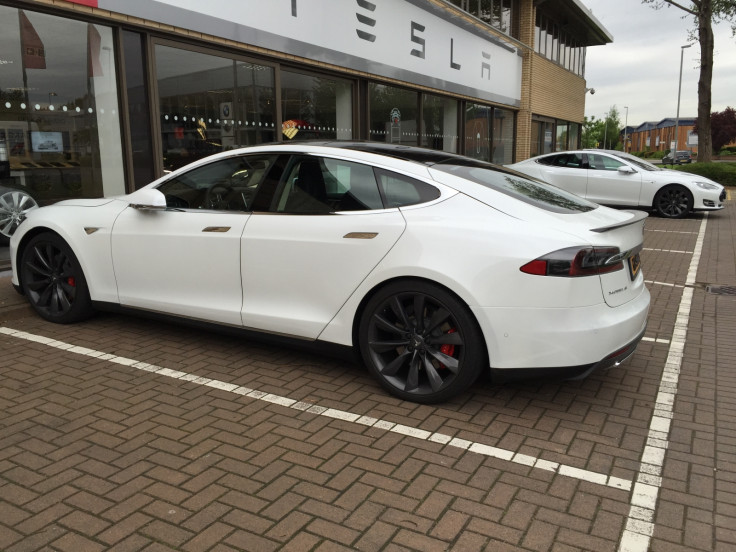Tesla Model S P85D first drive: This Ferrari-beater has a button for 'Insane Mode'

"You'll want to secure your bag," the Tesla press representative said, showing me a special space in the boot to put my laptop satchel. A strange request, I thought as I opened the door - but then she tapped at the car's touchscreen dashboard, switched on 'Insane' mode and all became clear.
Visually identical to the other versions of Model S, the P85D has a 470 horsepower electric motor in the back and combines it with a second, 221hp motor powering the front wheels.
This gives the Model S permanent four-wheel-drive and a total power output of 691hp and 687lb ft of torque - more than just about any other road car ever made, and completely unheard of in a five-seat saloon.
Even more startling is how the P85D - all 2.2 tonnes of it - can sprint from standstill to 60 miles per hour in a supercar-beating 3.1 seconds, a full second quicker than the P85+ it replaces.
So what does all that electric power feel like?
In the three days between driving the P85D and writing this review I've been asked a dozen times what it was like and I'm still struggling to come up with a single, coherent sentence. Stamping on the accelerator in Insane Mode shoves the car forward with an unrelenting force so great that it genuinely takes your breath away.
Acceleration times, 0-60mph (seconds)
- Porsche 918 Spyder - 2.2
- Ferrari LaFerrari - 2.4
- McLaren P1 - 2.6
- Tesla Model S P85D - 3.1
- McLaren F1 - 3.2
- Porsche 911 Turbo - 3.2
- Ferrari Enzo - 3.3
- Pagani Huayra - 3.3
- Lamborghini Murciélago LP640 - 3.3
- Ferrari 599 GTO - 3.4
You're pinned into the seat, blood drains from your face, you emit the noise of someone who's just been punched in the stomach, and remembering to breathe drops a few places on your to-do list as the car appears to defy physics.
It is nothing short of extraordinary, like being catapulted forward on a rollercoaster and made even more alien by the Tesla's near-complete lack of noise and drama.
Where the P85+ would kick its hips sideways and need reigning in by its traction control for a moment at low speeds, the extra traction of the D's four-wheel-drive removes this, giving you an instant, undiluted surge of acceleration.
Because each motor drives a single gear, there are no pauses to change cogs and no chance to catch your breath - until a discreet cough from your driving license suggests you reach for the pedal on the left. When you do, the P85D's disc brakes offer little in the way of feel (a problem exhibited by most electric vehicles) but do an adequate and reassuring job of hauling a car the weight of a Range Rover back down to reality.

Minutes earlier, I had been gliding the Tesla through traffic more easily than can ever be possible with a manual, petrol car.
There are no gears to think about and the motors' regenerative braking system, which harvests energy back into the battery pack when you lift off the accelerator, slows the car so much that you only need the brake pedal when coming to a complete stop.
But when the road clears and the speed limit increases, a prod of the accelerator is too much to resist. Press firmly from around 20mph and 60 appears less than two seconds later, the P85D dragging you there with such ease it feels like you're cheating, exploiting a vulnerability in how gravity works.
Tesla has jailbroken science and hacked technology meant to save the environment to produce a mundane-looking family car with the straight-line performance of a missile.
For fun, here's a video from Drag Times of passenger reactions to the P85D accelerating with Insane mode switched on:
Any other changes?
The second motor robs a small space from the front boot, but it's still large enough for an overnight bag or a few bags of shopping - and of course the cavernous rear boot is unaffected and can be fitted with two rear-facing child seats for an extra £2,500.
The press demonstrator I drove had the optional Alcantara dashboard and carbon fibre trim, but these can be specified on all other Model S's, too. Unfortunately the lack of change inside means the P85D has the same average interior which is no match for those from Audis, Jaguars, BMWs and Mercedes of the same price. I also still don't get along with the front seats, which lack the bolstering and side support expected from a car with such massive performance.
Incredibly, range - the all-important factor when buying an electric car - is almost completely unaffected by adding the second motor. Tesla claims the P85D will do 300 miles between charges, just 10 fewer than the 85D (£63,200), and 25 more than the entry-level 70D (£55,000). I only had an hour with the car so couldn't give a fair review of the car's power consumption, but IBTimes UK will be back for a longer stint with the car later this year once Tesla's right-hand-drive stock arrives.

Worth the premium?
Tesla has priced the P85D at £80,000, almost £17,000 more than the mid-range 85D, which has four-wheel-drive, 422hp, reaches 60mph in 4.4 seconds and has the same 155mph top speed.
Paying an extra £17,000 for faster acceleration is awfully expensive for a party trick. But it is one hell of a party trick. A defiant middle finger to electric car skeptics and physics alike, the P85D feels like it simply shouldn't be possible.
Petrolheads driving electric cars will lament the lack of manual gearboxes, flame-spitting exhausts, noise and drama - and I can't blame them, because so do I - but Tesla has to be applauded for the P85D. Here is a car which really didn't need to exist, but it does, it has more power than a Ferrari Enzo, is faster to 60 than a McLaren F1, is (fairly) sensibly priced, can seat five adults and two children in comfort and is free to recharge.
And it's got Insane Mode.
© Copyright IBTimes 2025. All rights reserved.






















